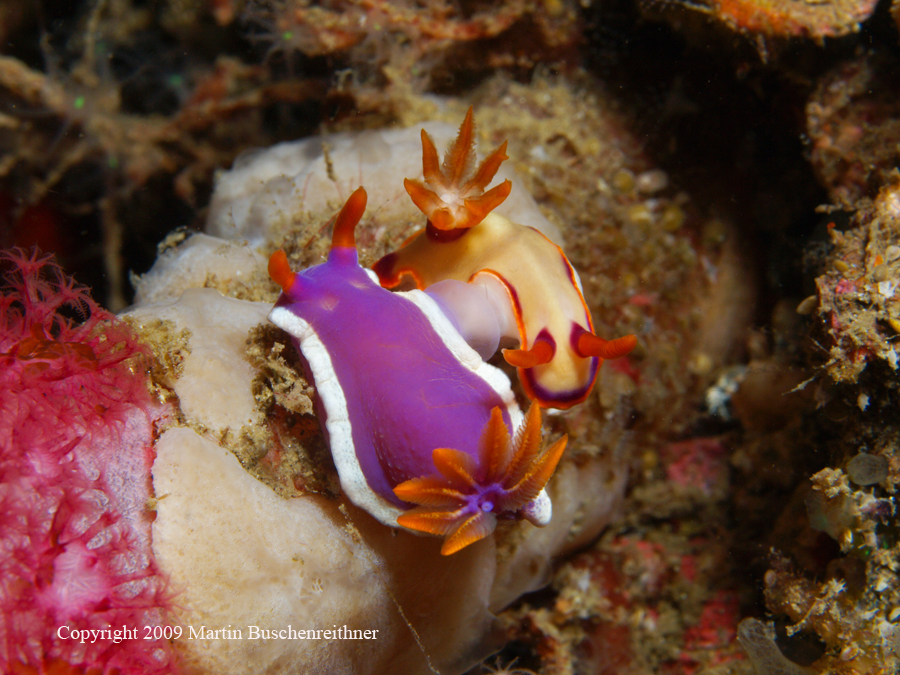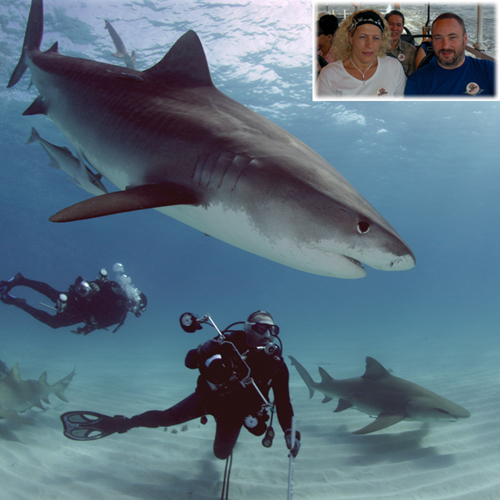 |
Hypselodoris sp.
Photographed by Martin BuschenreithnerNudi Falls, Lembeh Strait, Indonesia
March 2009
Photo taken with Olympus E-330, 50 mm Macro.
See in Indo-Pacific Nudibranchs and Sea Slugs
Well what do we do with this great photo? Identify the Slugs? Explain why two completely different looking slugs are mating? Announce a new marriage? Or ALL THE ABOVE?
To begin with, we have seen an increasing numbers of such photos on the Sea Slug Forum and even here on Mike's site. Some use these photos to argue that the two completely different colored slugs are the same species. Oh yeah, then where are all the intermediated color variations? Some even suggest that they are so closely related that they can mate and produce viable offspring. Okay - where are they? These mating have not produced anything that looks even like a hybrid (gas & electric sea slug). In fact, nothing at all. Come on. Careful phylogenetic research including, genetic protein analysis (being conducted at the California Academy of Sciences, in San Francisco) is showing that all of the strange pairing in the Hypselodoris bullocki (looking) complex, are in fact radically distinct (albeit undescribed) species.
Even cursory dissection of these two critters, seen above) has shown that one has acid secreting mantle glands and in the other there are none. Same species - hog wash.
There are many examples of two distinct species attempting to procreate in nature, but to no avail. A cross between a horse and a donkey produces a mule, but mules are sterile. How often does a bee distribute pollen from one plant species to another species? Nothing happens.
Some say - well dogs and cats cross breed and produce intermediary offspring. Sure they do, but they are all the same species. What they produces are different breeds and Heinz 57 mongrels. You can't mate a house cat with a Bob Cat and expect to get offspring. Of course not, they are different species.
Mating pairs between different species seems to be particularly common in Chromodorids . We do not actually know why this is. We really have no clue why species that are dramatically different even attempt to procreate. Hundreds of years of trying have produced nothing. Maybe they are just horny.
Gig Harbor, Washington
July, 2009
Sonja and Martin
 |
My wife Sonja and I live in Mautern - Austria. We dive for over 20 years around the world, but mainly in tropical waters as in the Indo-Pacific. We love diving, like any big fish, especially sharks but our heart belongs to the colorful small animals such as nudibranchs, from which we until now about 500 in 1500 shared dives could find. I photograph the moment with Olympus E 330 and Sea & Sea YS 110 flashes. In my collection are now more than 100,000 photos. www.martin-busch.magix.net The attached photo shows me at my favorite job, the underwater - fotografie. in the small section with my wife, she find even the little animal.
Send Martin email at ghostpipe@gmx.at WEBMASTER'S NOTES : Martin and Sonja are long time contributors to the Slug Site. As in many husband and wife teams, I suspect as Martin suggests, it is Sonja that finds the many nudibranchs that have found their way to presentation on the Site. Martin's skills as a photographer are unsurpassed! A couple of years ago in Bali, I had the good fortune to run into Martin and Sonja at Dive Paradise in the Tulamben area. After dinner Martin showed fellow divers his images taken that day! These were all unedited images, but nevertheless, I didn't see any that I would throw away. Martin certainly knows his system and how to get the best results out of it! What more can be said? |

|
